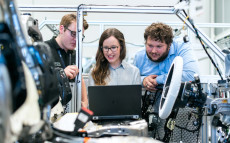- pathfindersAI
- Job Profile
Aerospace Engineering and Operations Technologists and Technicians
Summary
Aerospace Engineering and Operations Technologists and Technicians: A Career in the Skies
What They Do
Aerospace Engineering and Operations Technologists and Technicians play a pivotal role in the aviation and space industries, ensuring the seamless integration of technology and engineering in the realm of aerospace. These professionals are primarily engaged in maintaining, testing, and developing new aircraft and spacecraft components. They work closely with engineers to create and improve upon the technology that assures the efficiency and safety of aerospace vehicles. Their contributions are critical for the advancement of both commercial and defense aviation, as well as for space exploration endeavors.
Job Responsibilities
The responsibilities of an Aerospace Engineering and Operations Technologist and Technician are varied and multifaceted. They often collaborate with engineers to develop and test new aerospace systems and components. This can include anything from testing aircraft engines, interpreting results from simulations, to troubleshooting issues in flight control systems. Moreover, they are tasked with the meticulous examination of blueprints and technical manuals, ensuring all parts and systems meet stringent federal and industry standards. These technologists and technicians routinely employ computer-aided design (CAD) software for drafting and simulation purposes, thus guaranteeing precision in their work. The ability to document findings and generate comprehensive reports is also essential to their role, as these documents help in refining and improving upon existing technologies.
Essential Skills
Mastery in a variety of technical and soft skills is imperative for success in this field. First and foremost, proficiency in mathematics and physical sciences provides a strong foundation for understanding complex aerospace systems. Analytical thinking and problem-solving skills are crucial, given the complexity and sophistication of aerospace technology. Familiarity with software programs, particularly those used in CAD and simulations, is integral for day-to-day tasks. Attention to detail cannot be overstated; even minor errors can lead to catastrophic failures. Communication skills are also vital, as these professionals must effectively convey technical information to engineers and other team members. Additionally, organizational skills help manage multiple projects and deadlines efficiently.
Educational Pathways
Embarking on a career as an Aerospace Engineering and Operations Technologist and Technician typically starts with a focused educational pathway. Most positions require at least an associate’s degree in aerospace engineering technology or a related field from an accredited institution. Coursework often includes subjects such as physics, computer science, engineering principles, and specific aerospace-related studies. For those aiming to stand out in this competitive field, a bachelor’s degree might be advantageous. Additionally, participating in internships and cooperative education programs can provide hands-on experience that is highly valued by employers. Certifications, particularly those offered by recognized bodies like the Federal Aviation Administration (FAA), can further bolster one’s qualifications.
Career Prospects
The career prospects for Aerospace Engineering and Operations Technologists and Technicians are promising, driven by the continual advancement of aerospace technology and exploration. With the aerospace industry being a critical component of national defense and commercial transportation, job stability is relatively robust. Emerging sectors such as private space exploration and unmanned aerial vehicles (UAVs) are expanding the landscape of opportunities. As aerospace firms globally strive for innovation, there is a steady demand for skilled technologists and technicians who can support these advancements. According to the Bureau of Labor Statistics, employment in this field is expected to grow in the foreseeable future, underscoring the field’s viability and dynamism.
Conclusion
In conclusion, Aerospace Engineering and Operations Technologists and Technicians are essential contributors to the ever-advancing world of aerospace. Their technical proficiency, coupled with their problem-solving abilities, ensures that aviation and space exploration continue to evolve safely and efficiently. With ample educational pathways and a positive career outlook, pursuing a role in this field can be a rewarding choice for those passionate about aerospace technology. As the realm of flight continues to push boundaries, these professionals stand at the forefront, shaping the future of humanity’s journey through the skies and beyond.
Video
Compensation
| State | Median Salary | Median Hourly | Positions |
|---|---|---|---|
| AL | 75,690 | 36.39 | 290 |
| AZ | 55,550 | 26.71 | 190 |
| AR | * | * | 70 |
| CA | 92,360 | 44.40 | 1,530 |
| CO | 118,280 | 56.87 | 350 |
| CT | 76,540 | 36.80 | 90 |
| FL | 76,130 | 36.60 | 2,280 |
| GA | 77,640 | 37.33 | 150 |
| IN | 50,350 | 24.21 | 210 |
| KS | 61,430 | 29.53 | 820 |
| LA | 67,210 | 32.31 | 60 |
| MD | 86,560 | 41.62 | 260 |
| MI | 61,960 | 29.79 | 90 |
| NV | 98,410 | 47.31 | 90 |
| NY | 71,120 | 34.19 | 40 |
| NC | 80,140 | 38.53 | 130 |
| OH | 77,480 | 37.25 | 1,070 |
| PA | 55,570 | 26.71 | 40 |
| SC | 70,680 | 33.98 | 120 |
| TX | 75,660 | 36.38 | 570 |
| UT | 75,890 | 36.49 | 270 |
| VA | 81,900 | 39.37 | 160 |
| WA | 99,640 | 47.91 | 420 |
Similar Occupations
In this area you will find other occupations that are close to the one you were viewing in tasks, knowledge and work environment. If the primary job profile you are viewing isn't quite to your liking, take a look around and see what else is available.
Basic and Premium Accounts have more alternative occupations available than the Free account.

Aircraft Mechanics and Service Technicians - 49-3011.00
Aircraft Mechanics and Service Technicians are responsible for diagnosing, repairing, and maintaining the structural, mechanical, and electronic systems of airplanes and helicopters to ensure they operate safely and efficiently. They perform routine inspections, troubleshoot issues, and replace or repair components to meet stringent safety standards and regulatory requirements.
-
$75,020/yr
Median Pay -
137,630
Number of Jobs

Automotive Engineering Technicians - 17-3027.01
Automotive Engineering Technicians assist in the development, testing, and fine-tuning of vehicle systems and components by conducting performance assessments and implementing design improvements. They collaborate with engineers to troubleshoot issues, ensure compliance with safety standards, and enhance the efficiency and reliability of automotive technologies.
-
$64,020/yr
Median Pay -
38,930
Number of Jobs